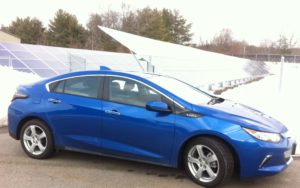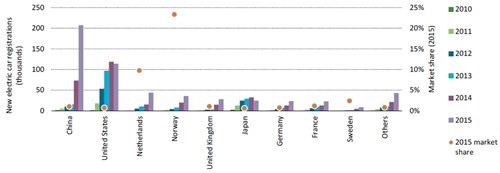As solar rapidly becomes more common, electric vehicles are becoming more common as well. The electric vehicle (EV) and hybrid electric vehicle (HEV) market grew 70% from 2014 to 2015 globally with 550,000 electric and hybrid cars sold worldwide in 2015 alone according to the International Energy Agency (IEA). 100,000 of those were in the U.S., second only to China with 200,000 vehicles (IEA). The market locally in Massachusetts grew by 37% in 2016 for the vehicles (Forbes).
Tax credits, rebates, lower costs of ownership, safety, and driving experience are all major benefits that prospective electric car buyers are factoring in when considering purchasing a new vehicle, especially as electric vehicle options continue to expand.
Electric vehicles and hybrid electric vehicles also play an important role in reducing imports of petroleum. According to the Department of Energy (DOE), in 2014, the United States imported about 27% of the petroleum it consumed, and transportation was responsible for nearly three-quarters of total U.S. petroleum consumption. Switching to electric vehicles therefore reduces the need for foreign oil.
How clean really are these cars? Electric vehicles, while they do have some greenhouse gas emissions associated with their use and manufacture, are significantly cleaner than conventional gasoline engines. For example, based on a 2015 study performed by the Union of Concerned Scientists, battery-electric vehicles have half the life cycle global warming emissions of gasoline vehicles.
Charging infrastructure is a key element to further adoption. Charging stations have been rapidly expanding domestically and internationally, with over 40,000 in the U.S. and an estimated 1.45 million globally according to DOE figures. Many major transportation corridors and public locations host charging stations that are either free or have a nominal fee.
With electric car sales expanding quickly in the U.S., many countries are seeing electric vehicles as a much more significant percentage share of their domestic car sales. For example, Netherlands and Norway have seen electric vehicle sales as a percentage of total sales, well above 7.5% of total sales with the Netherlands percentage of EV sales around 10% and Norway around 25% (IEA). These markets illustrate the burgeoning potential of these vehicles and the commercial opportunities for electric vehicle manufacturers.
U.S., China, and Japan, despite large and growing electric vehicle sales, are only in the early stages of EV technology capturing greater market share. Innovative and established car makers alike are racing to provide the electric vehicles that consumers are demanding and our economies and environment need.


